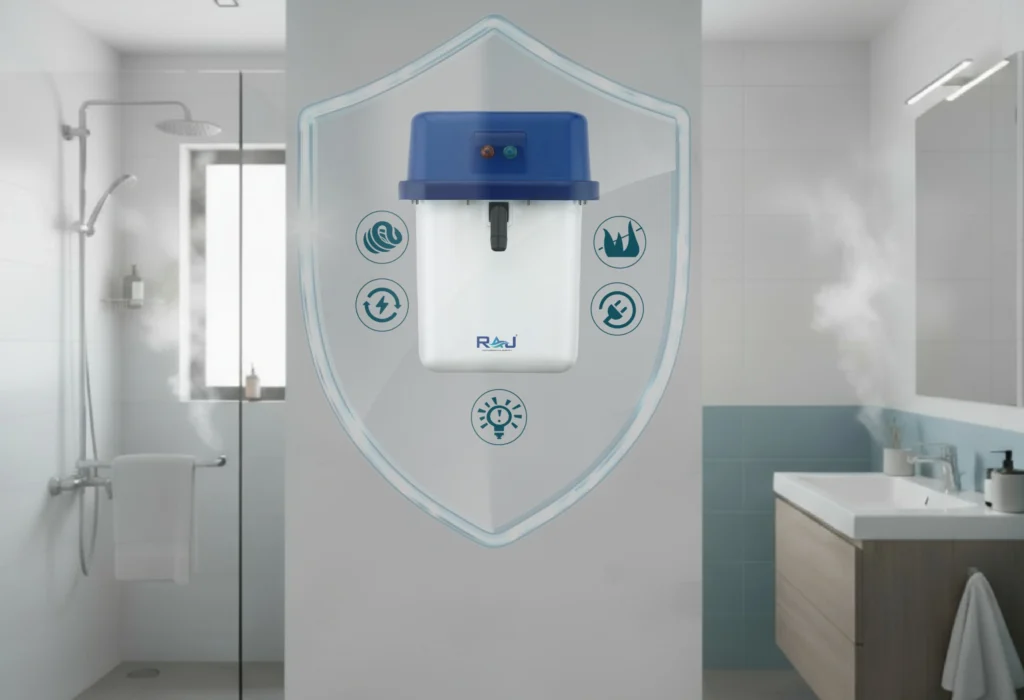A geyser also known as Water heater has become a must-have appliance in modern bathrooms, providing the comfort of warm water for showers, cleaning, and other daily tasks. While it brings convenience, improper usage can lead to safety hazards, high electricity bills, and a shorter appliance lifespan. With electricity prices steadily rising and safety concerns growing, it’s important to understand how to use a geyser in the bathroom safely and efficiently.
In this guide, we’ll explore everything you need to know from geyser safety tips to smart ways to save electricity with your geyser, helping you create a safe and cost-effective hot water experience for your home.
Understanding How a Geyser Works
Before you can use your geyser efficiently, it’s helpful to understand how it functions. A geyser works by using a heating element to warm water inside a tank or instant chamber. Once the water reaches the desired temperature, the thermostat automatically switches off the heating element to prevent overheating. The heated water is then ready for use through your shower or bathroom tap.
There are two main types of geysers. Instant geysers heat water on demand without storing it. They are compact, fast, and ideal for smaller households or bathrooms with limited space. However, they produce a limited water output at a time. Storage geysers, on the other hand, store a larger amount of water in a tank, making them suitable for bigger families or bathrooms where multiple people need hot water in quick succession. While storage geysers are convenient, they consume more electricity as they need to keep the stored water warm. Knowing which type of geyser you have helps you plan your usage for better performance and savings.
Safety Tips for Using a Geyser in the Bathroom
Safety should be your top priority when dealing with an electrical appliance in a wet environment. One of the most important things to remember is to avoid keeping the geyser on for long hours continuously. Extended usage can overheat the water and put unnecessary strain on the heating element, which may lead to damage or even accidents. It’s best to switch on the geyser about 10–15 minutes before you need hot water and turn it off once the water is ready.
Always make sure your hands are dry before operating the geyser’s switch or plug. Water and electricity are a dangerous combination, and even a small lapse can result in severe electric shocks. For added safety, install a Miniature Circuit Breaker (MCB). This device automatically cuts off the power supply in case of electrical faults, protecting your family from potential hazards such as short circuits or fire.
Another vital precaution is ensuring that your geyser has proper earthing and certified wiring. Faulty wiring or a lack of earthing can increase the risk of electrical accidents. Hiring a certified electrician for installation and regular check-ups can go a long way in preventing mishaps.
Maintaining a safe water temperature is also critical. Setting the thermostat too high not only wastes energy but can also cause scalding burns, especially for children or elderly family members. Keeping the water temperature between 45°C and 50°C provides comfort while staying safe. Finally, schedule annual servicing with a professional to inspect safety valves, thermostats, and internal parts. Regular maintenance ensures your geyser remains safe and reliable throughout the year.
How to Use a Geyser Efficiently to Save Electricity and Water
Using a geyser efficiently is not only good for the environment but also helps reduce your monthly electricity bills. The simplest habit you can adopt is switching off the geyser as soon as the water is heated. Leaving it on continuously consumes unnecessary power and shortens the appliance’s lifespan. If you have a busy schedule, consider installing a timer or smart plug to automatically turn the geyser on and off at specific times. This ensures hot water is ready exactly when you need it without the risk of forgetfulness.
Be mindful of the amount of water you heat. Avoid filling the entire tank when you only need a small quantity. Heating smaller amounts of water requires less time and energy. If you’re purchasing a new geyser, opt for one with PUF insulation, as it retains heat for longer, reducing the need for frequent reheating.
Another smart strategy is scheduling your geyser usage during non-peak electricity hours, which often come with lower rates in many regions. By aligning your geyser use with off-peak times, you can save money without compromising on comfort.
Common Mistakes to Avoid While Using Geysers
Many households unknowingly make mistakes that increase energy consumption or damage their geysers over time. One common error is keeping the geyser on overnight. This habit wastes electricity and puts continuous pressure on the heating element, raising the risk of malfunction. Neglecting regular cleaning of the water tank is another mistake. Over time, sediment and mineral deposits build up inside the tank, reducing heating efficiency and leading to rust or leaks.
Ignoring warning signs is equally dangerous. If you notice unusual noises, water leaks, or visible rust around your geyser, it’s crucial to take action immediately. Small problems can quickly escalate into major issues if left unattended.
Maintenance Tips for a Longer Geyser Lifespan
Proper maintenance not only ensures safety but also extends the lifespan of your geyser. Begin by cleaning the water tank every six months to prevent sediment buildup, which can strain the heating element and lower performance. Regularly inspect the heating element and replace it if you notice wear or reduced efficiency. The safety valve which controls pressure inside the tank should also be checked and replaced when necessary to avoid potential hazards.
Finally, schedule professional servicing once a year. A certified technician can conduct a thorough check-up, ensuring all parts are functioning properly and making any necessary replacements or repairs before problems escalate.
Conclusion
A geyser brings unmatched convenience to your bathroom, but using it without proper care can lead to high electricity bills, safety risks, and frequent repairs. By following these geyser safety tips and adopting smart habits for efficient geyser use, you can enjoy warm water whenever you need it while keeping your home safe and your energy costs under control. Safe and efficient usage doesn’t just save money it also protects your family and ensures your appliance serves you well for many years to come.

